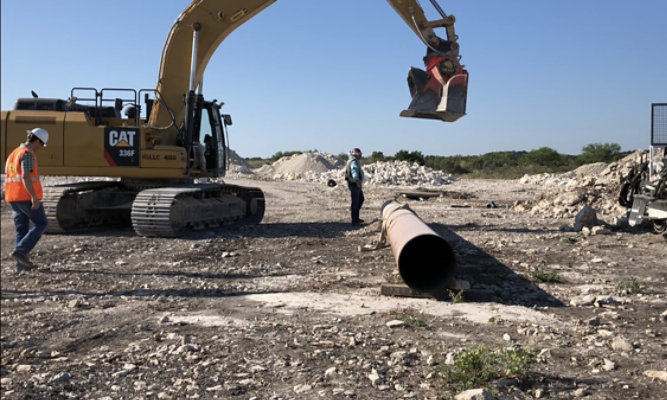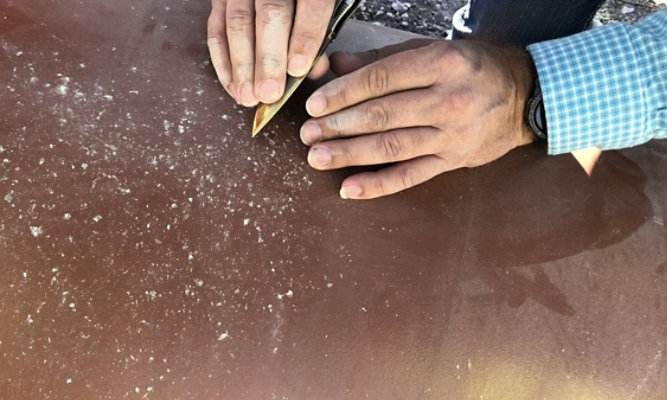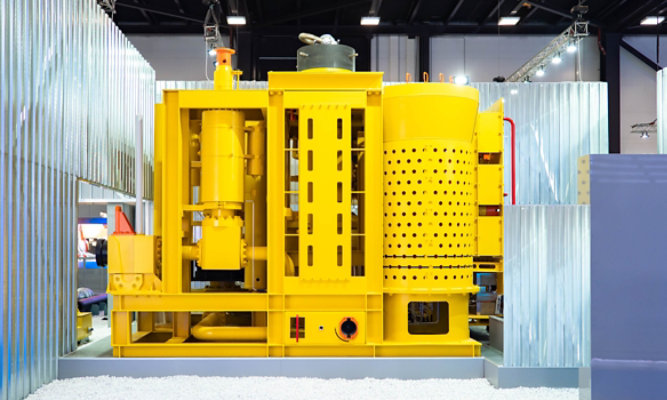Reel-Lay Pipe Coatings Enable Long-Term, High-Temperature Reliability and Real-Time Savings
High Strength Combined with High Flexibility Enable Installation Efficiencies
by Dr. Jeffrey David Rogozinski, Global Product Director – Fusion-Bonded Epoxy/Pipe, for Sherwin-Williams Protective & Marine

As subsea oil production ventures into deeper waters, operators and Engineering, Procurement and Construction companies (EPCs) continue to seek operational solutions that blend long-term reliability with lower capital costs for well installations and maintenance. As a result, they are minimizing the addition of expensive topwater assets like fixed platforms and instead are focusing investment on the seafloor. This strategy increases the use of subsea pipelines and tiebacks, enabling operators to increase the number and distance of wells linked to existing topwater rigs, helping to bring additional offshore production online more cost effectively.
But even then, operators face substantial costs and challenges when installing pipelines and tiebacks using traditional technologies, including the S-lay and J-lay methods for laying pipelines. Both of these methods involve specialized vessels and crews, who assemble subsea tiebacks by connecting a succession of pre-coated 40-foot pipe sections from onboard a barge. As each section is connected, it is lowered into the water to extend the pipeline along the seafloor.
Both the S-lay and J-lay methods pose significant and costly technical and quality demands on a ship and crew, since they involve storing, handling, aligning, welding, coating, insulating and lowering what is, essentially, a moving structure. Each successive pre-finished and pre-coated piping section must be lowered into a cradle, aligned with the preceding pipe and then girth welded to it, either with a coupling or a butt-to-butt joint. Once a quality girth weld is made, it must then be cleaned and inspected, then heated to accept the application of a powder-based fusion-bonded epoxy (FBE) anti-corrosion coating for protection.
To reduce the time involved in coating for S-lay and J-lay pipeline assembly, in which drying/curing time is a major factor, Sherwin-Williams Protective & Marine developed a low application temperature (LAT) anti-corrosion coating. This coating, which incorporates FBE chemistry, combines the ability to apply it at a lower pipe-surface temperature (for less heating required) with a faster curing reaction, enabling the entire joint-coating process to be completed in minutes – a 30-40% time savings over previous coating methods. Once the anti-corrosion coat has been applied, it is then topped by a water-tight, impact-resistant insulation barrier. This is typically a thick (4-8 inch) polyolefin or molded aliphatic polymer. Only then can the newly connected section be lowered to make way for the next one.
As seen in Figures 1 and 2, the S-lay method assembles pipe sections horizontally, requiring the backbone of the tieback structure to flex twice, forming the outline of an “S.” The newer J-lay method orients the pipe assembly, welding, coating and insulating process vertically, substantially reducing the flexing forces placed on the pipeline being installed.
Using these methods, and specially designed vessels, skilled crews can lay tieback lines at typical rates of two to five kilometers per day. This output translates to the equivalent of producing 164 to 410 quality field joints (welded, inspected, coated and insulated connections) on 40-foot pipe sections per day, conditions permitting. However, that pace can be significantly improved by opting for a newer alternative pipeline installation method that’s gaining industry traction for its greater efficiencies and lower costs.
A New Approach: Reel-Lay Installations
In an effort to reduce the cost and improve the quality of subsea tieback production for smaller diameter lines (16-inch outside diameter and smaller), the industry has adopted the reel-lay method (Figure 3). This method uses a land-based production plant to assemble, finish and wind extremely long lengths of tieback pipe onto large diameter “reels.” Typical reels hold from 1 to 1.5 kilometers of finished pipeline (equivalent to 82 to 123 lengths of 40-foot pipe), but they can be produced to longer lengths, depending on the pipe diameter and application. Then, the only welding and coating applications that need to occur onboard the installation vessel are when joining the next reel of pipeline that was prepared onshore. As a result, reel-lay applications are capable of installing 15 to 20 kilometers per day – a significant increase compared to S-lay and J-lay methods.
The cost, production and quality assurance advantages of land-based reel fabrication for subsea pipelines are both obvious and enormous. Compared to shipboard fabrication, virtually every requirement of the process is simplified: material sourcing, handling and storage; staffing; onsite welding and inspection; coating and insulation; and environmental and quality controls. Without the daily complication of changing weather and ocean conditions at sea, onshore production conditions and overall quality can be easily monitored, even automated to a high degree.
Material and performance requirements for reel-lay installations are similar to those for the S-lay and J-lay methods. These include the need for a robust, but ductile steel pipe, along with weld joints, coatings and insulation materials that can tolerate a minimum 1.5-degree pipe diameter bend – the minimum bend radius required to spool a pipe onto a reel. During installation, the finished length will be subject to additional flexing stress, since reel laying resembles a continuous S-lay process, slowed only when it becomes necessary to field-join the end of one reel to the beginning of the next one.
Needed: Coatings That Bend, but Don’t Break
The long-term performance of reel-lay tiebacks and pipelines depends in large part on the ability of anti-corrosion coatings to maintain a range of key qualities. First, they must adhere to pipe surfaces, including any irregularities around weld joints, to prevent or mitigate cathodic disbondment or the spread of minor surface corrosion due to undercutting. Second, they must maintain consistent barrier properties – keeping out water, electrolytes, gases or acids – despite exposure to high internal temperatures and significant temperature gradients between the inside and outside diameter of the pipe. Third, their chemistries must be synergistic with the operation of cathodic protection systems. Fourth, and vitally for reel-laying performance, they must tolerate even severe bending, flexing or impact stresses better than the underlying pipe, since these stresses could produce coating breaks, chips or voids that invite corrosion damage.
Due to continued advancements in epoxy composite coatings, producing a durable, hard and impact-resistant, yet highly flexible, coating that can endure high-temperature stresses is a challenging, but possible task. The difficulty isn’t so much in producing tough epoxy composites, since hard, high-temperature ones are quite common. What is difficult is producing a thin epoxy coating film that balances that kind of glass-like toughness and temperature tolerance with the necessary flexibility.
Subsea wells are typically being drilled deeper today, so oil and pipeline temperatures are rising. To tolerate a specific high temperature (i.e., maintain a stable molecular structure and tight physical and chemical crosslinks under heat stress), an epoxy coating must have a glass transition (Tg) temperature that exceeds the temperature to which it is exposed (e.g., the oil/pipe or environmental temperature.) If the Tg of a coating is exceeded, the coating becomes plastic and its physical structure and properties are compromised.
But a high Tg isn’t enough to ensure subsea performance. High Tg epoxies can be glassy and brittle, making them subject to cracking or shattering under bending stress. To be acceptable for reel-laying pipe, a high Tg anti-corrosion coating must also tolerate significant flexing. That combination requires an epoxy chemistry with some very special characteristics: a molecular-level composite.
Selective Reactions Build Coatings Flexibility
The components in molecular-level composites, such as in the Sherwin-Williams Dura-Sub™ C family of FBE coatings, are designed to react in a very specific way that allows them to form particular coating characteristics. Upon application, the components of the coating “phase-separate,” with fast-reacting, contiguous-phase molecules rapidly forming the latticework of crosslinks that give the coating its high Tg, high temperature tolerance, and characteristic barrier properties, toughness and impact resistance.
The contiguous phases of the coating react and form so quickly that they surround and trap slower-reacting molecules, forming “occlusions” throughout the crosslinked structure. The distribution of these “occluded phase” molecular structures are key to the coating’s flexibility. Singly and collectively, the molecules within these occlusions function as pillows or shock absorbers within the rigid crosslinked structure, absorbing and dissipating impact and flexing forces across the coating surface. The occlusions help to prevent forces from concentrating in a single place where they could crack or break the harder lattice of crosslinks.
Developing molecular-level composites that could deliver a high Tg with high flexibility was a lengthy process, involving multiple generations of chemistries as well as laboratory and field testing. Early on, it was relatively easy to create coatings containing molecules that formed long, stiff polymer chains that remained stable. However, tests showed that these first-generation coatings would develop a pattern of cracks under bending stress (see the top sample in Figure 4, which cracked at just a 1.5-degree pipe diameter bend). Next, experimentations with epoxy molecules that formed strong polymer chains using smaller, shorter molecules showed promise. These improved molecules formed a “tighter” crosslink structure, but they tended to allow a greater penetration of air and moisture (porosity) in the finished coating than desired.
Finally, a third generation of coatings produced the appropriate balance of properties: high Tg, toughness, low porosity and high flexibility (see the lower sample in Figure 4, which shows high flexibility and no coating cracking at a 2.0-degree pipe diameter bend). The flexibility of the coatings was proven through a range of bend tests conducted at varying temperatures (Figure 5). These tests, along with qualifications to more conventional standards, such as ISO 12944 CX, demonstrate the balance of performance properties required both for reel-lay and long-term subsea performance.
Qualified Expectations
Reel-laying offers a productive and cost-effective alternative to older methods of laying subsea tieback pipelines. But making it globally viable requires the confidence and support of offshore operators and EPCs, based on proof that the full range of materials and technologies needed to implement reel-lay installations will perform as expected in all conditions.
Given the advancements of the Sherwin-Williams Dura-Sub C powder-based, molecular-level composite coatings, with their balanced properties, reel-lay installations can be performed without concern about long-term coatings performance. Naturally, S-lay and J-lay installations can benefit from the same coating properties and offer the same peace of mind. When properly applied, these coatings meet all relevant quality and performance standards for any subsea pipeline installation, even at elevated operating temperatures.
ABOUT THE AUTHOR
Dr. Jeffrey David Rogozinski is Global Product Director – Fusion-Bonded Epoxy/Pipe for Sherwin-Williams Protective & Marine. With more than 30 years’ experience in coatings and academia, he is responsible for developing protective coatings, powder coatings, resins and additives for the oil and gas, pipeline, and bridge and highway markets. His coatings science emphasis is on researching and testing polymer synthesis and structure-property characterization. He is a member of several coatings associations and a consultant for global specification writing for CSA Group, the International Organization for Standardization (ISO), ASTM International, NACE International and others. Rogozinski holds a doctorate in applied science for polymer and composite chemistry. Contact: Jeffrey.Rogozinski@sherwin.com
Figure 1. In S-lay pipeline installations, installers assemble pipe sections horizontally, with the pipeline then forming the outline of an “S” as it’s lowered into the sea.
S-Lay is 4-5km/day: vessel cost $350k/day
Figure 2. With the J-lay method, the pipe assembly, welding, coating and insulating processes are all done vertically, causing the pipeline to form a “J” profile underwater.
J-Lay is 2-2.5km/day: vessel cost $500k/day
Figure 3. For reel-lay installations, long lengths of pipeline are fabricated onshore and reeled onto spools. The only coating applications required offshore are when installers join two long lengths of pipe.
Reel-Lay is 15-20km/day: vessel cost $200k/day
Figure 4. Initial iterations of new FBE coatings showed cracking at just a 1.5-degree pipe diameter bend (top), while the third-generation coating performed significantly better with no cracking at a 2.0-degree pipe diameter bend.
Figure 5. Coated samples faced multiple bend tests at various radii and temperatures to determine the coating’s performance.
Discover More
Industry Expertise and Innovation
See how we help customers find customized solutions for their project and application challenges.
Our Oil & Gas Expertise
Explore our industry solutions and technology to help protect your assets.
LEARN MOREProduct Lookup
Find out more about our innovative coatings for a variety of industries.
FIND A PRODUCT

